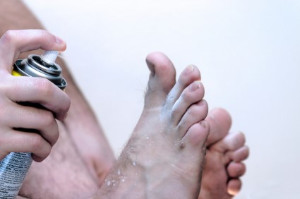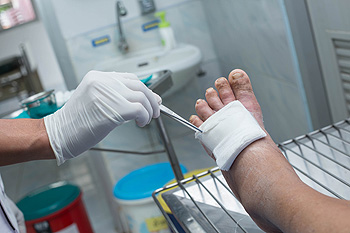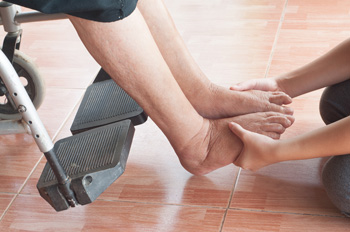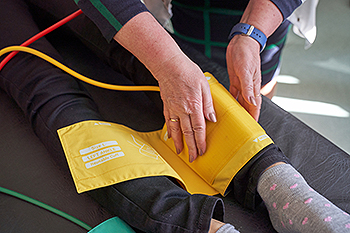Connect With Us
Blog
Items filtered by date: March 2022
Where Is the Fungus That Causes Athlete’s Foot Found?
 Tinea pedis, which is known as athlete’s foot, is considered to be a fungal infection. The skin on the feet is affected, and it may itch and turn red. It can be difficult to cure, but despite the fact it is not known to be a serious infection. This condition can be contagious, and it is suggested to refrain from sharing towels, socks, or shoes. The fungus that causes athlete’s foot thrives in warm and moist environments. These can include public swimming pools, locker room floors, and showers. The symptoms that patients experience can consist of blisters, cracked skin on the feet, and the affected foot may itch and burn. A proper diagnosis often consists of having a skin test taken, and this is necessary in choosing the right treatment option. If you have symptoms of athlete’s foot, it is suggested that you speak with a podiatrist as quickly as possible, who can determine what the best course of treatment is for you.
Tinea pedis, which is known as athlete’s foot, is considered to be a fungal infection. The skin on the feet is affected, and it may itch and turn red. It can be difficult to cure, but despite the fact it is not known to be a serious infection. This condition can be contagious, and it is suggested to refrain from sharing towels, socks, or shoes. The fungus that causes athlete’s foot thrives in warm and moist environments. These can include public swimming pools, locker room floors, and showers. The symptoms that patients experience can consist of blisters, cracked skin on the feet, and the affected foot may itch and burn. A proper diagnosis often consists of having a skin test taken, and this is necessary in choosing the right treatment option. If you have symptoms of athlete’s foot, it is suggested that you speak with a podiatrist as quickly as possible, who can determine what the best course of treatment is for you.
Athlete’s Foot
Athlete’s foot is often an uncomfortable condition to experience. Thankfully, podiatrists specialize in treating athlete’s foot and offer the best treatment options. If you have any questions about athlete’s foot, consult with one of our podiatrists from Sutera and Jones Surgical Podiatry. Our doctors will assess your condition and provide you with quality treatment.
What Is Athlete’s Foot?
Tinea pedis, more commonly known as athlete’s foot, is a non-serious and common fungal infection of the foot. Athlete’s foot is contagious and can be contracted by touching someone who has it or infected surfaces. The most common places contaminated by it are public showers, locker rooms, and swimming pools. Once contracted, it grows on feet that are left inside moist, dark, and warm shoes and socks.
Prevention
The most effective ways to prevent athlete’s foot include:
- Thoroughly washing and drying feet
- Avoid going barefoot in locker rooms and public showers
- Using shower shoes in public showers
- Wearing socks that allow the feet to breathe
- Changing socks and shoes frequently if you sweat a lot
Symptoms
Athlete’s foot initially occurs as a rash between the toes. However, if left undiagnosed, it can spread to the sides and bottom of the feet, toenails, and if touched by hand, the hands themselves. Symptoms include:
- Redness
- Burning
- Itching
- Scaly and peeling skin
Diagnosis and Treatment
Diagnosis is quick and easy. Skin samples will be taken and either viewed under a microscope or sent to a lab for testing. Sometimes, a podiatrist can diagnose it based on simply looking at it. Once confirmed, treatment options include oral and topical antifungal medications.
If you have any questions, please feel free to contact one of our offices located in Media, Glen Mills, Riddle Memorial Hospital, and Concordville, PA . We offer the newest diagnostic and treatment technologies for all your foot care needs.
Simple Foot Care Can Help Maintain Mobility
Keeping your feet as healthy as possible through proper foot care can help you maintain your mobility into old age. Your body weight plays a big role in your foot health, and the pounds can add up as we age. This extra weight not only places more strain on your feet, but makes you more susceptible to developing conditions such as arthritis, diabetes, and circulatory issues that affect the feet. So, it is important to do all you can to reach and maintain your ideal weight. Doing simple things like keeping your feet clean, dry, and moisturized can help prevent conditions such as calluses, cracked heels, and more. Keeping your toenails trimmed straight across, but not so short that they grow into surrounding skin, will help prevent ingrown toenails. Wearing supportive footwear that fits well is another important component to protecting your feet and maintaining your mobility. Stretching your feet and Achilles tendon will keep your feet, ankles, muscles and connective tissues flexible and strong. Getting your feet checked regularly by a podiatrist will help keep your feet healthy and also allow you to gain more knowledge about how to improve and maintain your mobility.
Everyday foot care is very important to prevent infection and other foot ailments. If you need your feet checked, contact one of our podiatrists from Sutera and Jones Surgical Podiatry. Our doctors can provide the care you need to keep you pain-free and on your feet.
Everyday Foot Care
Often, people take care of their bodies, face and hair more so than they do for their feet. But the feet are a very important aspect of our bodies, and one that we should pay more attention to. Without our feet, we would not be able to perform most daily tasks.
It is best to check your feet regularly to make sure there are no new bruises or cuts that you may not have noticed before. For dry feet, moisturizer can easily be a remedy and can be applied as often as necessary to the affected areas. Wearing shoes that fit well can also help you maintain good foot health, as well as making it easier to walk and do daily activities without the stress or pain of ill-fitting shoes, high heels, or even flip flops. Wearing clean socks with closed shoes is important to ensure that sweat and bacteria do not accumulate within the shoe. Clean socks help to prevent Athlete’s foot, fungi problems, bad odors, and can absorb sweat.
If you have any questions please feel free to contact one of our offices located in Media, Glen Mills, Riddle Memorial Hospital, and Concordville, PA . We offer the newest diagnostic and treatment technologies for all your foot and ankle needs.
Heel Pain Can Be Treated!
Healing of a Broken Ankle
 Broken ankles are usually caused by the ankle turning, twisting, or rolling while walking, running, or participating in sports. An ankle can also break from repetitive stress (stress fracture) or high-impact trauma to the ankle, like a fall or an auto accident (traumatic ankle fracture). Some ankle fractures can occur where bones break but remain in correct alignment, while in other instances, portions of the bone become separated or misaligned. Pain and swelling will typically occur in the ankle area and parts of the foot, and might radiate up to the knee. Putting weight on the affected ankle can make all symptoms worse. Different types of fractures require different treatment based on alignment and stability of the ankle. X-rays, a CT scan or an MRI may be needed to determine the extent of the injury. Seeing a podiatrist will help determine which type of fracture has been sustained and the proper course of treatment to help preserve the ankle joint for life.
Broken ankles are usually caused by the ankle turning, twisting, or rolling while walking, running, or participating in sports. An ankle can also break from repetitive stress (stress fracture) or high-impact trauma to the ankle, like a fall or an auto accident (traumatic ankle fracture). Some ankle fractures can occur where bones break but remain in correct alignment, while in other instances, portions of the bone become separated or misaligned. Pain and swelling will typically occur in the ankle area and parts of the foot, and might radiate up to the knee. Putting weight on the affected ankle can make all symptoms worse. Different types of fractures require different treatment based on alignment and stability of the ankle. X-rays, a CT scan or an MRI may be needed to determine the extent of the injury. Seeing a podiatrist will help determine which type of fracture has been sustained and the proper course of treatment to help preserve the ankle joint for life.
Broken ankles need immediate treatment. If you are seeking treatment, contact one of our podiatrists from Sutera and Jones Surgical Podiatry. Our doctors can provide the care you need to keep you pain-free and on your feet.
Broken Ankles
A broken ankle is experienced when a person fractures their tibia or fibula in the lower leg and ankle area. Both of these bones are attached at the bottom of the leg and combine to form what we know to be our ankle.
When a physician is referring to a break of the ankle, he or she is usually referring to a break in the area where the tibia and fibula are joined to create our ankle joint. Ankles are more prone to fractures because the ankle is an area that suffers a lot of pressure and stress. There are some obvious signs when a person experiences a fractured ankle, and the following symptoms may be present.
Symptoms of a Fractured Ankle
- Excessive pain when the area is touched or when any pressure is placed on the ankle
- Swelling around the area
- Bruising of the area
- Area appears to be deformed
If you suspect an ankle fracture, it is recommended to seek treatment as soon as possible. The sooner you have your podiatrist diagnose the fracture, the quicker you’ll be on the way towards recovery.
If you have any questions, please feel free to contact one of our offices located in Media, Glen Mills, Riddle Memorial Hospital, and Concordville, PA . We offer the newest diagnostic and treatment technologies for all your foot care needs.
The Prevalence of PAD
Peripheral artery disease (PAD) is a condition that causes poor circulation in the extremities due to a narrowing or blockage of blood vessels that supply those areas. PAD is particularly dangerous because it is often asymptomatic, especially in its initial stages. As the disease progresses, symptoms such as leg pain, muscle weakness, numbness, and skin discoloration may appear. PAD is more common in people who smoke, have high blood pressure, high cholesterol, or a history of atherosclerosis or diabetes. It is also more common in older adults than it is in those under age 60. After age 60, PAD is seen in men more frequently than in women. For more information about PAD, please consult with a podiatrist.
Peripheral artery disease can pose a serious risk to your health. It can increase the risk of stroke and heart attack. If you have symptoms of peripheral artery disease, consult with one of our podiatrists from Sutera and Jones Surgical Podiatry. Our doctors will assess your condition and provide you with quality foot and ankle treatment.
Peripheral artery disease (PAD) is when arteries are constricted due to plaque (fatty deposits) build-up. This results in less blood flow to the legs and other extremities. The main cause of PAD is atherosclerosis, in which plaque builds up in the arteries.
Symptoms
Symptoms of PAD include:
- Claudication (leg pain from walking)
- Numbness in legs
- Decrease in growth of leg hair and toenails
- Paleness of the skin
- Erectile dysfunction
- Sores and wounds on legs and feet that won’t heal
- Coldness in one leg
It is important to note that a majority of individuals never show any symptoms of PAD.
Diagnosis
While PAD occurs in the legs and arteries, Podiatrists can diagnose PAD. Podiatrists utilize a test called an ankle-brachial index (ABI). An ABI test compares blood pressure in your arm to you ankle to see if any abnormality occurs. Ultrasound and imaging devices may also be used.
Treatment
Fortunately, lifestyle changes such as maintaining a healthy diet, exercising, managing cholesterol and blood sugar levels, and quitting smoking, can all treat PAD. Medications that prevent clots from occurring can be prescribed. Finally, in some cases, surgery may be recommended.
If you have any questions, please feel free to contact one of our offices located in Media, Glen Mills, Riddle Memorial Hospital, and Concordville, PA . We offer the newest diagnostic and treatment technologies for all your foot care needs.
Why Diabetes and Podiatry Go Together
 There are a variety of complications to the feet that diabetes can cause, and some of them can even lead to amputation. These problems occur because diabetic patients are prone to losing the sensation in their feet, making it difficult to notice problems in their early stages. Diabetes can also cause poor blood flow in the feet, which ultimately leads to both numbness and a slower healing process for wounds. This is why it is important for diabetic patients to develop a foot care routine that includes checking the feet every day for wounds and sores, keeping the feet clean, keeping the skin soft and smooth, and finding properly fitting footwear. Regular checkups with a podiatrist are also suggested for diabetic patients. Anyone with diabetes who has further questions or concerns shouldn’t hesitate to consult with a podiatrist near them.
There are a variety of complications to the feet that diabetes can cause, and some of them can even lead to amputation. These problems occur because diabetic patients are prone to losing the sensation in their feet, making it difficult to notice problems in their early stages. Diabetes can also cause poor blood flow in the feet, which ultimately leads to both numbness and a slower healing process for wounds. This is why it is important for diabetic patients to develop a foot care routine that includes checking the feet every day for wounds and sores, keeping the feet clean, keeping the skin soft and smooth, and finding properly fitting footwear. Regular checkups with a podiatrist are also suggested for diabetic patients. Anyone with diabetes who has further questions or concerns shouldn’t hesitate to consult with a podiatrist near them.
Diabetic foot care is important in preventing foot ailments such as ulcers. If you are suffering from diabetes or have any other concerns about your feet, contact one of our podiatrists from Sutera and Jones Surgical Podiatry. Our doctors can provide the care you need to keep you pain-free and on your feet.
Diabetic Foot Care
Diabetes affects millions of people every year. The condition can damage blood vessels in many parts of the body, especially the feet. Because of this, taking care of your feet is essential if you have diabetes, and having a podiatrist help monitor your foot health is highly recommended.
The Importance of Caring for Your Feet
- Routinely inspect your feet for bruises or sores.
- Wear socks that fit your feet comfortably.
- Wear comfortable shoes that provide adequate support.
Patients with diabetes should have their doctor monitor their blood levels, as blood sugar levels play such a huge role in diabetic care. Monitoring these levels on a regular basis is highly advised.
It is always best to inform your healthcare professional of any concerns you may have regarding your feet, especially for diabetic patients. Early treatment and routine foot examinations are keys to maintaining proper health, especially because severe complications can arise if proper treatment is not applied.
If you have any questions please feel free to contact one of our offices located in Media, Glen Mills, Riddle Memorial Hospital, and Concordville, PA . We offer the newest diagnostic and treatment technologies for all your foot and ankle needs.
Blog Archives
- July 2024
- June 2024
- May 2024
- April 2024
- March 2024
- February 2024
- January 2024
- December 2023
- November 2023
- October 2023
- September 2023
- August 2023
- July 2023
- June 2023
- May 2023
- April 2023
- March 2023
- February 2023
- January 2023
- December 2022
- November 2022
- October 2022
- September 2022
- August 2022
- July 2022
- June 2022
- May 2022
- April 2022
- March 2022
- February 2022
- January 2022
- December 2021
- November 2021
- October 2021
- September 2021
- August 2021
- July 2021
- June 2021
- May 2021
- April 2021
- March 2021
- February 2021
- January 2021
- December 2020
- November 2020
- October 2020
- September 2020
- August 2020
- July 2020
- June 2020
- May 2020
- April 2020
- March 2020
- February 2020
- January 2020
- December 2019
- November 2019
- October 2019
- September 2019
- August 2019
- July 2019
- June 2019
- May 2019
- April 2019
- March 2019
- February 2019
- January 2019
- December 2018
- November 2018
- October 2018
- September 2018
- August 2018
- July 2018
- June 2018
- May 2018
- April 2018
- March 2018
- February 2018
- January 2018
- December 2017
- November 2017
- October 2017
- September 2017
- August 2017
- July 2017
- June 2017
- May 2017
- April 2017
- March 2017
- February 2017
- January 2017
- December 2016
- November 2016
- October 2016
- September 2016
- August 2016
- July 2016
- June 2016
- May 2016
- April 2016
- March 2016
- February 2016
- January 2016
- December 2015
- November 2015
- October 2015
- September 2015
- August 2015
- July 2015
- June 2015
- May 2015
- April 2015
- March 2015
- February 2015
- January 2015
- December 2014
- November 2014
- October 2014
- September 2014



